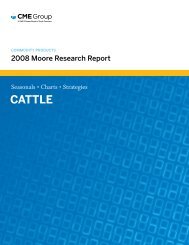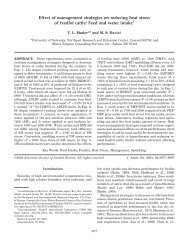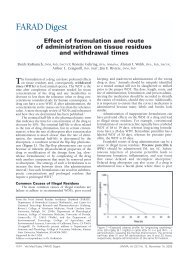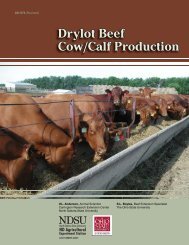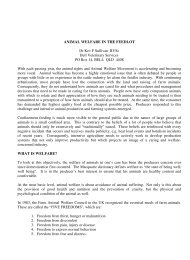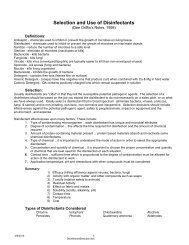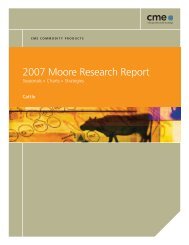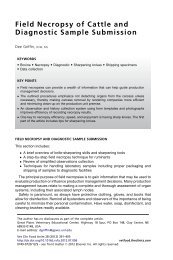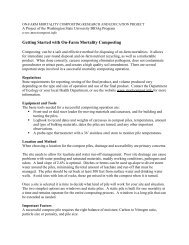CRIMES WITHOUT CONSEQUENCES - gpvec
CRIMES WITHOUT CONSEQUENCES - gpvec
CRIMES WITHOUT CONSEQUENCES - gpvec
You also want an ePaper? Increase the reach of your titles
YUMPU automatically turns print PDFs into web optimized ePapers that Google loves.
industry slaughter guidelines<br />
In 2003, the Animal Welfare Audit Program of FMI-NCCR began conducting audits of<br />
supplier slaughter plants upon the request of its members. In the first year of the program,<br />
audits were conducted at six non-poultry slaughter plants, and in year two, five poultry<br />
and one non-poultry slaughter plants were audited. 246 The number and identity of retailers<br />
participating in the program is not publicized.<br />
Certain individual retailers, such as restaurants and grocery stores, have developed their<br />
own animal care guidelines, along with a process for auditing their suppliers’ compliance<br />
with those guidelines. Fast food restaurants, including McDonald’s Corporation, Burger<br />
King Corporation, Wendy’s International and Jack-in-the-Box, were the first retailers to<br />
establish programs to monitor the treatment of animals by the animal agriculture industry.<br />
In fact, their efforts in this area influenced the creation of the FMI-NCCR audit program,<br />
mentioned above. 247<br />
9.4 Compliance with industry guidelines<br />
The results of industry and third-party animal care audits are generally not released to<br />
the public. However, since 1999, Temple Grandin has compiled annual slaughter plant<br />
welfare audits and posted the results on her website. 248 Her findings for cattle and pig<br />
slaughter plants are summarized in Tables 25 (cattle) and 26 (pigs). The data show<br />
that stunning effectiveness for both cattle and pigs improved dramatically from the<br />
time of Grandin’s first audit in 1996 and 1999, when the first fast food audits began.<br />
However, since 1999, the scores have fluctuated, with pig slaughter plants producing<br />
higher stunning effectiveness scores than cattle slaughter plants. It should be noted that<br />
each year, less than 100 of the 800 federal livestock slaughter plants are audited. These<br />
plants are most likely among the country’s largest, and many of them are audited at least<br />
annually, while most small U.S. plants have never undergone a third-party audit.<br />
Grandin has compiled welfare audit results for poultry slaughter plants since 2004.<br />
That year, only 22 of 47 plants (47 percent) met the requirement of properly stunning<br />
99 percent or more of chickens on their first audit. Seven of the 47 plants (15 percent)<br />
failed both their first and second audits. 249 In 2005, Grandin compared the audits<br />
conducted for NCC with those conducted for a major unnamed retail customer. Because<br />
of the way in which the NCC audits were scored 26 percent (5 plants) passed even<br />
though they had serious abuses that should have, in Grandin’s opinion, resulted in<br />
failure. The plants passed the audits because they did well on less critical aspects of the<br />
audit. Grandin believes that the NCC audit form is valid but that “the scoring system<br />
must be made more strict.” 250<br />
246 Ibid. See also the Retail Food Industry Auditing Program section of Farm Sanctuary’s Farm Animal<br />
Welfare report.<br />
247 Ibid.<br />
248 See http://www.grandin.com.<br />
249 Although NCC guidelines allow a 2 percent failure rate for effective stunning, some customers (retailers)<br />
require a failure rate of 1 percent or less. See Grandin T, 2004 restaurant animal welfare audits of stunning and<br />
handling in federally inspected U.S. and Canadian beef, veal, pork, lamb, and poultry slaughter plants.<br />
(http://www.grandin.com/survey/2004.restaurant.audits.html)<br />
250 Grandin T, 2005 poultry welfare audits. (http://www.grandin.com/survey/2005.poultry.audits.html)<br />
85




